Influence of Land Use and Land Cover on the Quality of Surface Waters and Natural Wetlands in the Miranda River Watershed, Brazilian Pantanal
Abstract
:1. Introduction
2. Materials and Methods
2.1. Study Area
2.2. Delimitation of Influence Areas
2.3. Land Use and Land Cover in the Miranda River Watershed
2.4. Water Quality Data Collection
2.5. Correlation between Land Use and Land Cover and Water Quality
2.6. Influence of Wetlands on Water Quality in the Miranda River Watershed
3. Results and Discussion
3.1. Changes in Land Use and Land Cover in the Miranda River Watershed
3.2. Water Quality in the Miranda River Watershed
3.3. Water Quality Index
3.4. Correlation between Land Use and Land Cover and Water Quality
3.5. Influence of Wetlands on Water Quality
3.5.1. Thermotolerant Coliforms
3.5.2. Dissolved Oxygen and Biochemical Oxygen Demand Assessment
3.5.3. Total Nitrogen Assessment
3.5.4. Total Phosphorus Assessment
3.5.5. Total Solids Assessment
3.5.6. Turbidity Assessment
3.5.7. pH Assessment
3.5.8. Water Quality Index (WQI)
4. Conclusions
Author Contributions
Funding
Institutional Review Board Statement
Informed Consent Statement
Data Availability Statement
Acknowledgments
Conflicts of Interest
References
- Arenas-Sánchez, A.; Rico, A.; Vighi, M. Effects of Water Scarcity and Chemical Pollution in Aquatic Ecosystems: State of the Art. Sci. Total Environ. 2016, 572, 390–403. [Google Scholar] [CrossRef] [PubMed]
- IPEA Ipea—Objetivos Do Desenvolvimento Sustentável. Available online: https://www.ipea.gov.br/ods/index.html (accessed on 24 November 2022).
- von Sperling, M.; de Lemos Chernicharo, C.A. Biological Wastewater Treatment in Warm Climate Regions, Vol. 1; Reprinted; IWA: London, UK, 2006; ISBN 978-1-84339-002-2. [Google Scholar]
- Song, Y.; Song, X.; Shao, G.; Hu, T. Effects of Land Use on Stream Water Quality in the Rapidly Urbanized Areas: A Multiscale Analysis. Water 2020, 12, 1123. [Google Scholar] [CrossRef]
- Braga, B.; Hespanhol, I.; Conejo, J.L.; Mierzwa, J.C.; de Barros, M.T.; Spencer, M.; Porto, M.; Nucci, N.; Juliano, N.; Eiger, S.; et al. Introdução à Engenharia Ambiental; 3a Edição; de Fraga, S., Ed.; Bookman: Porto Alegre, Brazil, 2021; ISBN 978-85-8260-556-1. [Google Scholar]
- Shi, P.; Zhang, Y.; Li, Z.; Li, P.; Xu, G. Influence of Land Use and Land Cover Patterns On Seasonal Water Quality At Multi-Spatial Scales. CATENA 2017, 151, 182–190. [Google Scholar] [CrossRef]
- de Mello, K.; Valente, R.A.; Randhir, T.O.; dos Santos, A.C.A.; Vettorazzi, C.A. Effects of Land Use and Land Cover On Water Quality Of Low-Order Streams In Southeastern Brazil: Watershed Versus Riparian Zone. CATENA 2018, 167, 130–138. [Google Scholar] [CrossRef]
- Giri, S.; Qiu, Z. Understanding the Relationship of Land Uses and Water Quality in Twenty First Century: A review. J. Environ. Manag. 2016, 173, 41–48. [Google Scholar] [CrossRef] [PubMed]
- Ullah, K.A.; Jiang, J.; Wang, P. Land Use Impacts on Surface Water Quality by Statistical Approaches. Glob. J. Environ. Sci. Manag. 2018, 4, 231–250. [Google Scholar] [CrossRef]
- de Mello, K.; Taniwaki, R.H.; de Paula, F.R.; Valente, R.A.; Randhir, T.O.; Macedo, D.R.; Leal, C.G.; Rodrigues, C.B.; Hughes, R.M. Multiscale Land Use Impacts on Water Quality: Assessment, Planning, And Future Perspectives in Brazil. J. Environ. Manag. 2020, 270, 110879. [Google Scholar] [CrossRef] [PubMed]
- Menezes, J.P.C.; Bittencourt, R.P.; Farias, M.d.S.; Bello, I.P.; Fia, R.; de Oliveira, L.F.C. Relação Entre Padrões De Uso E Ocupação Do Solo E Qualidade Da Água Em Uma Bacia Hidrográfica Urbana. Eng. Sanit. Ambient. 2016, 21, 519–534. [Google Scholar] [CrossRef]
- Dias, R.Z.; Baptista, G.M.d.M. Wetland Nutrient Retention and Multitemporal Growth—Case Study of Riacho Fundo’s Wetland. Acta Limnol. Bras. 2015, 27, 254–264. [Google Scholar] [CrossRef]
- Fisher, J.; Acreman, M.C. Wetland nutrient removal: A review of the evidence. Hydrol. Earth Syst. Sci. 2004, 8, 673–685. [Google Scholar] [CrossRef]
- Silva, J.; Abdon, M.; Pott, A.; Mauro, R. Fragile Ecosystem: The Brazilian Pantanal Wetland. In Encyclopedia of Life Support Systems; Sanchez, L.E., Ed.; Eolss Publishers Co. Ltd.: Oxford, UK, 2009; pp. 302–339. [Google Scholar]
- Projeto MapBiomas—Coleção 6 Da Série Anual de Mapas de Cobertura e Uso Da Terra Do Brasil. Available online: http://brasil.mapbiomas.org/ (accessed on 28 March 2024).
- IMASUL IMASUL. Relatórios de Monitoramento Da Qualidade Das Águas Superficiais de Mato Grosso Do Sul, 2020. Available online: http://www.imasul.ms.gov.br/Relatorios-de-Monitoramento-Da-Qualidade-Das-Aguas-Superficiais/ (accessed on 28 March 2024).
- CETESB, E.S.T.C.; CETESB. Environmental Sanitation Technology Company Relatório de Qualidade Das Águas Interiores Do Estado de São Paulo. São Paulo, Brazil. 2008. Available online: http://cetesb.sp.gov.br/Aguas-Interiores/Wpcontent/Uploads/Sites/12/2013/11/Relatorio_2008.Zip (accessed on 28 March 2024).
- MATO GROSSO DO SUL. Deliberation CECA/MS N° 36, de 27 de Junho de 2012. In Provides for the Classification of Surface Water Bodies and Establishes Environmental Guidelines for Their Classification, as Well as Establishing the Guidelines, Conditions and Standards for the Release of Effluents within the State of Mato Grosso Do Sul, and Provides Other Measures; Instituto de Meio Ambiente de Mato Grosso Do Sul: Campo Grande, Brazil, 2012. [Google Scholar]
- American Public Health Association (APHA); American Water Works Association; Water Environment Federation. Standard Methods for the Examination of Water and Wastewater, 24th ed.; Lipps, W.C., Braun-Howland, E.B., Baxter, T.E., Eds.; APHA Press: Washington, DC, USA, 2023. [Google Scholar]
- ASTM D888-12e1; Standard Test Methods for Dissolved Oxygen in Water. ASTM International: West Conshohocken, PA, USA, 2018.
- ABNT NBR 13796:1997-04-30; Água-Determinação de Nitrogênio Orgãnico, Kjeldahl e Total—Métodos Macro e Semimicro Kjeldahl. ABNT, Associação Brasileira de Normas Técnicas: Rio de Janeiro, Brazil, 1997.
- IBGE, Instituto Brasileiro de Geografia e Estatística. Biomas e Sistema Costeiro-Marinho Do Brasil-PGI. Available online: https://www.ibge.gov.br/Apps/Biomas/#/Home (accessed on 28 March 2024).
- Ferraz, R.G.B. Antropização Da Bacia Hidrográfica Do Rio Miranda: Alterações Climáticas, Recursos Naturais e Desenvolvimento. Master’s Thesis, UCDB, Campo Grande, MS, Brazil, 2006. [Google Scholar]
- Padovani, C.R. Conversão Da Vegetação Natural Do Pantanal Para Uso Antrópico de 1976 Até 2017 e Projeção Para 2050. Comun. Técnico 2017, 109, 1–6. [Google Scholar]
- Landau, E.C.; Resende, R.M.S.; Matos Neto, F.D.C. Evolução Da Área Ocupada Por Pastagens. In Dinâmica da Produção Agropecuária e Da Paisagem Natural No Brasil Nas Últimas Décadas: Produtos de Origem Animal e Da Silvicultura; Landau, E.C., De Silva, G.A., Moura, L., Hirsch, A., Guimarães, D.P., Eds.; Embrapa: Brasília, DF, Brazil, 2020; Volume 3, pp. 1555–1578, Chapter 46. [Google Scholar]
- Lamas, F.M.; Artigo-A Dinâmica Da Agricultura Em Mato Grosso Do Sul. EMBRAPA 2021. Available online: https://www.Embrapa.br/Busca-de-Noticias/-/Noticia/65083174/Artigo---a-Dinamica-Da-Agricultura-Em-Mato-Grosso-Do-Sul (accessed on 28 March 2024).
- MMA Ministério Do Meio Ambiente. Brasil Resolução CONAMA N° 357 de 18 de Março de 2005. Dispõe Sobre a Classificação Dos Corpos de Água e Diretrizes Ambientais Para o Seu Enquadramento, Bem Como Estabelece as Condições e Padrões de Lançamento de Efluentes, e Dá Outras Providências; MMA Ministério Do Meio Ambiente: Brasília, Brazil, 2005; pp. 58–63. [Google Scholar]
- Bergier, I.; Assine, M.L. (Eds.) Dynamics of the Pantanal Wetland in South America; Springer International Publishing: Berlin/Heidelberg, Germany, 2016; Volume 37. [Google Scholar] [CrossRef]
- Dise, N.B. Biogeochemical Dynamics III: The Critical Role of Carbon in Wetlands. In The Wetlands Handbook; Maltby, E.E., Barker, T., Eds.; Wiley-Blackwell: Oxford, UK, 2009; pp. 249–265. [Google Scholar] [CrossRef]
- Souza, A.V.V. Avaliação Da Influência Dos Usos e Ocupação Do Solo Na Qualidade Da Água Do Rio Vermelho No Sudeste de Mato Grosso. Master’s Thesis, Programa de Pós-Graduação Em Geografia, Universidade Federal de Mato Grosso, Rondonópolis, MT, Brazil, 2015; p. 82. [Google Scholar]
- Lima, A.F. Dinâmica Da Qualidade Da Água Na Bacia Paraguai/Diamantino—Mato Grosso. Master’s Thesis, Universidade Estadual Do Mato Grosso, Tangará Da Serra, MT, Brazil, 2017; p. 51. [Google Scholar]
- Calheiros, D.F.; Ferreira, C.J.A. Alterações Limnológicas No Rio Paraguai (“dequada”) e o Fenômeno Natural de Mortandade de Peixes No Pantanal Mato-Grossense; EMBRAPA-CPAPMS: Corumbá, MS, Brazil, 1996; 51p. [Google Scholar]
- Zampella, R.A.; Procopio, N.A.; Lathrop, R.G.; Dow, C.L. Relationship of Land-Use/Land-Cover Patterns and Surface-Water Quality in The Mullica River Basin1. JAWRA J. Am. Water Resour. Assoc. 2007, 43, 594–604. [Google Scholar] [CrossRef]
- Kibena, J.; Nhapi, I.; Gumindoga, W. Assessing the Relationship Between Water Quality Parameters and Changes in Landuse Patterns in The Upper Manyame River, Zimbabwe. Phys. Chem. Earth, Parts A/B/C 2014, 67–69, 153–163. [Google Scholar] [CrossRef]
- Dos Santos, J.P. Influências Da Composição e Estrutura Da Paisagem Sobre a Qualidade Da Água Em Múltiplas Extensões Espaciais Na Unidade Hidrológica Do Rio Doce Em Minas Gerais. Master’s Thesis, Universidade Federal de Minas Gerais, Belo Horizonte, MG, Brazil, 2020. Available online: http://hdl.handle.net/1843/36487 (accessed on 28 March 2024).
- Chen, D.; Elhadj, A.; Xu, H.; Xu, X.; Qiao, Z. A Study on the Relationship between Land Use Change and Water Quality of the Mitidja Watershed in Algeria Based on GIS and RS. Sustainability 2020, 12, 3510. [Google Scholar] [CrossRef]
- Padovani, C.R. Dinâmica Espaço-Temporal Das Inundações Do Pantanal. Ph.D. Thesis, Ecologia de Agroecossistemas, Universidade de São Paulo, Piracicaba, Brazil, 2010. [Google Scholar] [CrossRef]
- Yu, X.; Hawley-Howard, J.; Pitt, A.L.; Wang, J.-J.; Baldwin, R.F.; Chow, A.T. Water Quality of Small Seasonal Wetlands in the Piedmont Ecoregion, South Carolina, USA: Effects of Land Use and Hydrological Connectivity. Water Res. 2015, 73, 98–108. [Google Scholar] [CrossRef]
- Knox, A.K.; Dahlgren, R.A.; Tate, K.W.; Atwill, E.R. Efficacy of Natural Wetlands to Retain Nutrient, Sediment and Microbial Pollutants. J. Environ. Qual. 2008, 37, 1837–1846. [Google Scholar] [CrossRef] [PubMed]
- Wilcock, R.J.; Müller, K.; van Assema, G.B.; Bellingham, M.A.; Ovenden, R. Attenuation of Nitrogen, Phosphorus and E. coli Inputs from Pasture Runoff to Surface Waters by a Farm Wetland: The Importance of Wetland Shape and Residence Time. Water Air Soil Pollut. 2012, 223, 499–509. [Google Scholar] [CrossRef]
- Jeng, H.; Hong, Y.-J. Assessment of a Natural Wetland for Use in Wastewater Remediation. Environ. Monit. Assess. 2005, 111, 113–131. [Google Scholar] [CrossRef]
- Muniz, C.C. Composição da comunidade íctica em área limnética, relacionada ao ciclo hidrológico nas baías da Salobra e Negra, no Pantanal de Cáceres-MT. Master’s thesis, 2005, Programa De Pós-Graduação Em Ciências Biológicas. Universidade Federal de Mato Grosso, Cuiabá-MT. 71p. Available online: https://ufmt.br/curso/ppgecb/pagina/publicacoes/11175 (accessed on 20 June 2024).
- Menezes Junior, M.Q.d.M.; Junior, E.S.O.; de Souza, C.A. The “Decoada” Phenomenon Effect on the Paraguay River Water Quality, Northern Pantanal. Rev. Ibero-Am. Ciências Ambient. 2020, 11, 612–623. [Google Scholar] [CrossRef]
- de Oliveira, M.D.; Calheiros, D.F.; Padovani, C.R. Mapeamento e Descrição Das Áreas de Ocorrência Dos Eventos de Decoada No Pantanal; Boletim de Pesquisa e Desenvolvimento; Embrapa Pantanal: Corumbá, Brazil, 2013; Volume 121, Available online: https://ainfo.cnptia.embrapa.br/digital/bitstream/item/83348/1/BP121.pdf (accessed on 28 March 2024).
- Uuemaa, E.; Palliser, C.C.; Hughes, A.O.; Tanner, C.C. Effectiveness of a Natural Headwater Wetland for Reducing Agricultural Nitrogen Loads. Water 2018, 10, 287. [Google Scholar] [CrossRef]
- White, J.R.; Reddy, K.R. Biogeochemical Dynamics I: Nitrogen Cycling in Wetlands. In The Wetlands Handbook; Maltby, E.E., Barker, T., Eds.; Wiley-Blackwell: Oxford, UK, 2009; pp. 213–227. [Google Scholar] [CrossRef]
- Fisher, J.; Stratford, C.; Buckton, S. Variation in Nutrient Removal in Three Wetland Blocks in Relation To Vegetation Composition, Inflow Nutrient Concentration And Hydraulic Loading. Ecol. Eng. 2009, 35, 1387–1394. [Google Scholar] [CrossRef]
- Walton, C.R.; Zak, D.; Audet, J.; Petersen, R.J.; Lange, J.; Oehmke, C.; Wichtmann, W.; Kreyling, J.; Grygoruk, M.; Jabłońska, E.; et al. Wetland Buffer Zones for Nitrogen and Phosphorus Retention: Impacts of Soil Type, Hydrology and Vegetation. Sci. Total Environ. 2020, 727, 138709. [Google Scholar] [CrossRef]
- Gericke, A.; Nguyen, H.H.; Fischer, P.; Kail, J.; Venohr, M. Deriving a Bayesian Network to Assess the Retention Efficacy of Riparian Buffer Zones. Water 2020, 12, 617. [Google Scholar] [CrossRef]
- Reddy, K.R.; Kadlec, R.H.; Flaig, E.; Gale, P.M. Phosphorus Retention in Streams and Wetlands: A Review. Crit. Rev. Environ. Sci. Technol. 1999, 29, 83–146. [Google Scholar] [CrossRef]
- Marois, D.E.; Mitsch, W.J.; Song, K.; Miao, S.; Zhang, L.; Nguyen, C.T. Estimating the Importance of Aquatic Primary Productivity for Phosphorus Retention in Florida Everglades Mesocosms. Wetlands 2015, 35, 357–368. [Google Scholar] [CrossRef]
- Neves, A.; Santos, F. Nem Tudo São Flores No Pantanal. Ciência Hoje 2008, 245, 71–73. [Google Scholar]
- Dodds, W.K. The Role of Periphyton in Phosphorus Retention in Shallow Freshwater Aquatic Systems. J. Phycol. 2003, 39, 840–849. [Google Scholar] [CrossRef]
- Richardson, C.J.; Vaithiyanathan, P. Biogeochemical Dynamics II: Cycling and Storage of Phosphorus in Wetlands. In The Wetlands Handbook; Maltby, E., Barker, T., Eds.; Wiley-Blackwell: Oxford, UK, 2009; pp. 228–248. ISBN 978-1-4443-1581-3. [Google Scholar]
- Chang, H.; Makido, Y.; Foster, E. Effects of land use change, wetland fragmentation, and best management practices on total suspended solids concentrations in an urbanizing Oregon watershed, USA. J. Environ. Manag. 2021, 282, 111962. [Google Scholar] [CrossRef]
- Juneau Watershed Partnership. Final Report Duck Creek Nancy Street Wetland Water Quality Assessment. 2018. Available online: https://dec.alaska.gov/media/17879/2018-duck-creek-nancy-st-wetland-assessment.pdf (accessed on 20 June 2024).
- Schmutz, S.; Moog, O. Dams: Ecological Impacts and Management. In Riverine Ecosystem Management: Science for Governing Towards a Sustainable Future; Schmutz, S., Sendzimir, J., Eds.; Aquatic Ecology Series; Springer International Publishing: Cham, Switzerland, 2018; pp. 111–127. ISBN 978-3-319-73250-3. [Google Scholar]
- Sánchez-Carrillo, S.; Álvarez-Cobelas, M.; Angeler, D.G. Sedimentation in the Semi-Arid Freshwater Wetland Las Tablas de Daimiel (Spain). Wetlands 2001, 21, 112–124. [Google Scholar] [CrossRef]
- Crossetti, L.O.; Cardoso, L.d.S.; Callegaro, V.L.M.; da Silva, S.M.A.; Werner, V.R.; Rosa, Z.M.; Marques, D.M.L.d.M. Influence of the Hydrological Changes on the Phytoplantkton Structure and Dynamics in a Subtropical Wetland-Lake System. Acta Limnol. Bras. 2007, 19, 315–329. [Google Scholar]
- Reid, R.; Mosley, L. Comparative Contributions of Solution Geochemistry, Microbial Metabolism and Aquatic Photosynthesis to the Development of High pH in Ephemeral Wetlands in South East Australia. Sci. Total Environ. 2016, 542, 334–343. [Google Scholar] [CrossRef] [PubMed]
- Gitau, J.K. Effectiveness of Natural Wetland in Waste Water Treatment: A Case Study of Tibia Wetland, Limuru Municipality, Kenya. Master’s Thesis, Kenyatta University, Nairobi, Kenya, 2014. [Google Scholar]
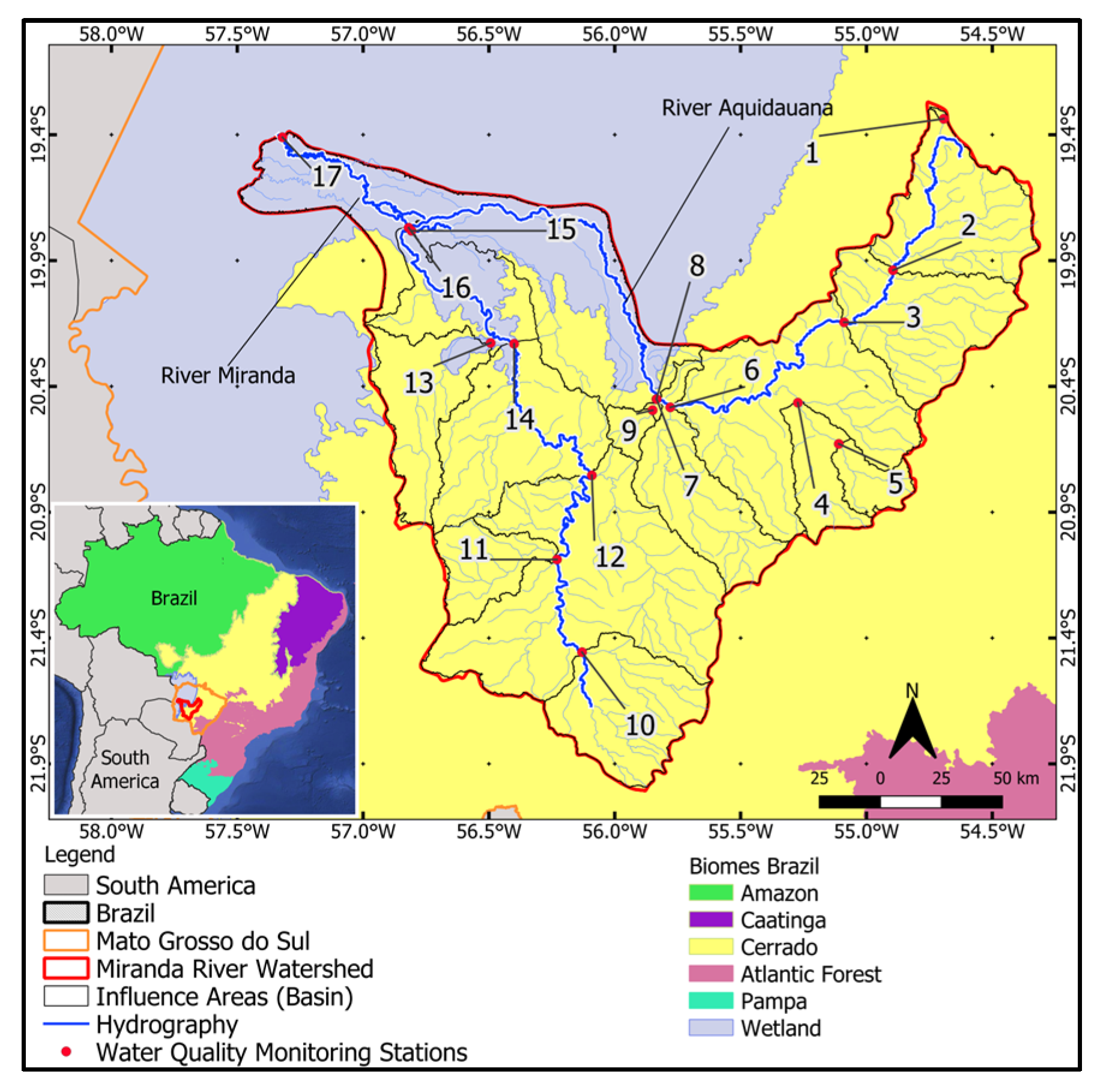
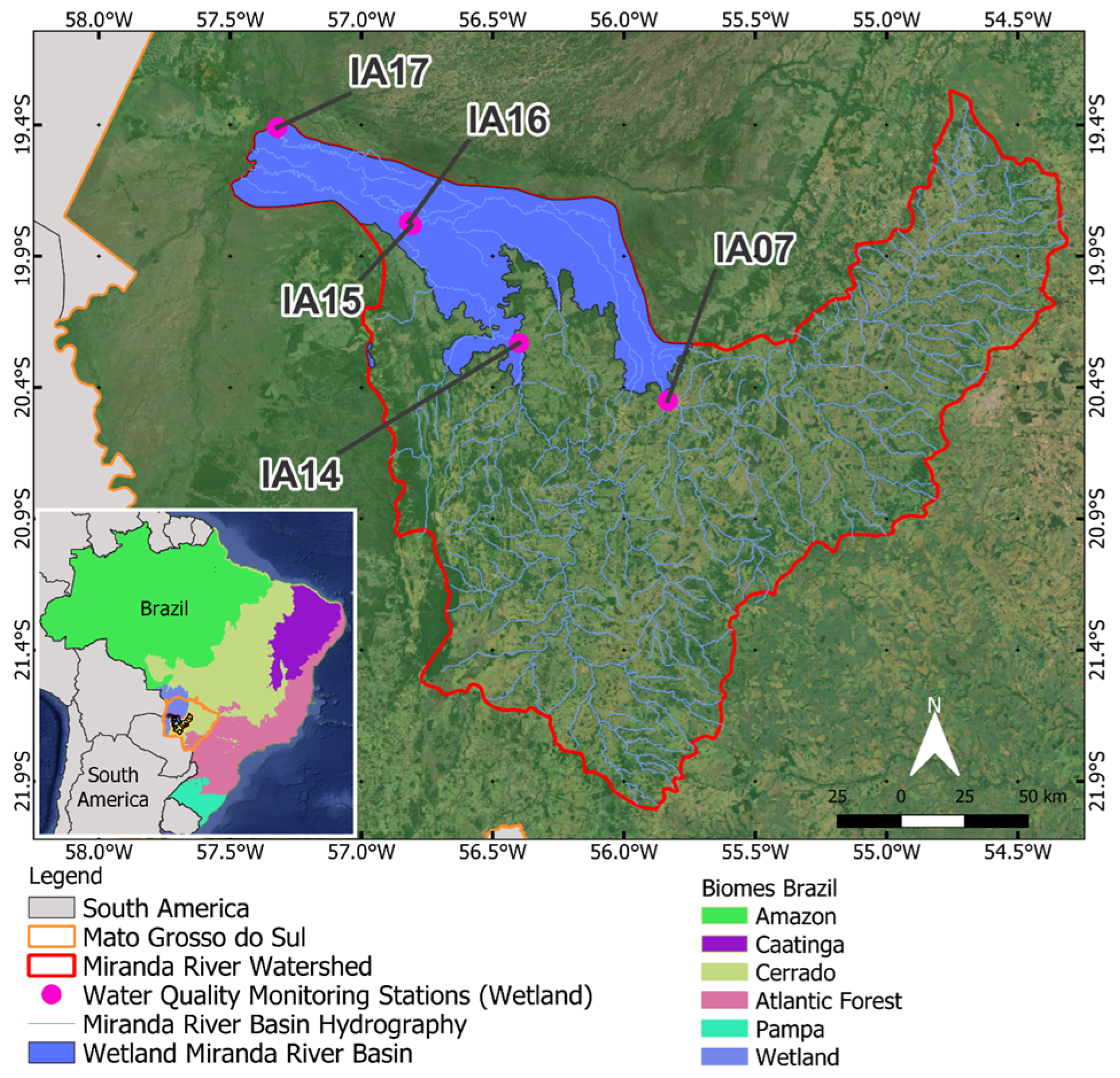
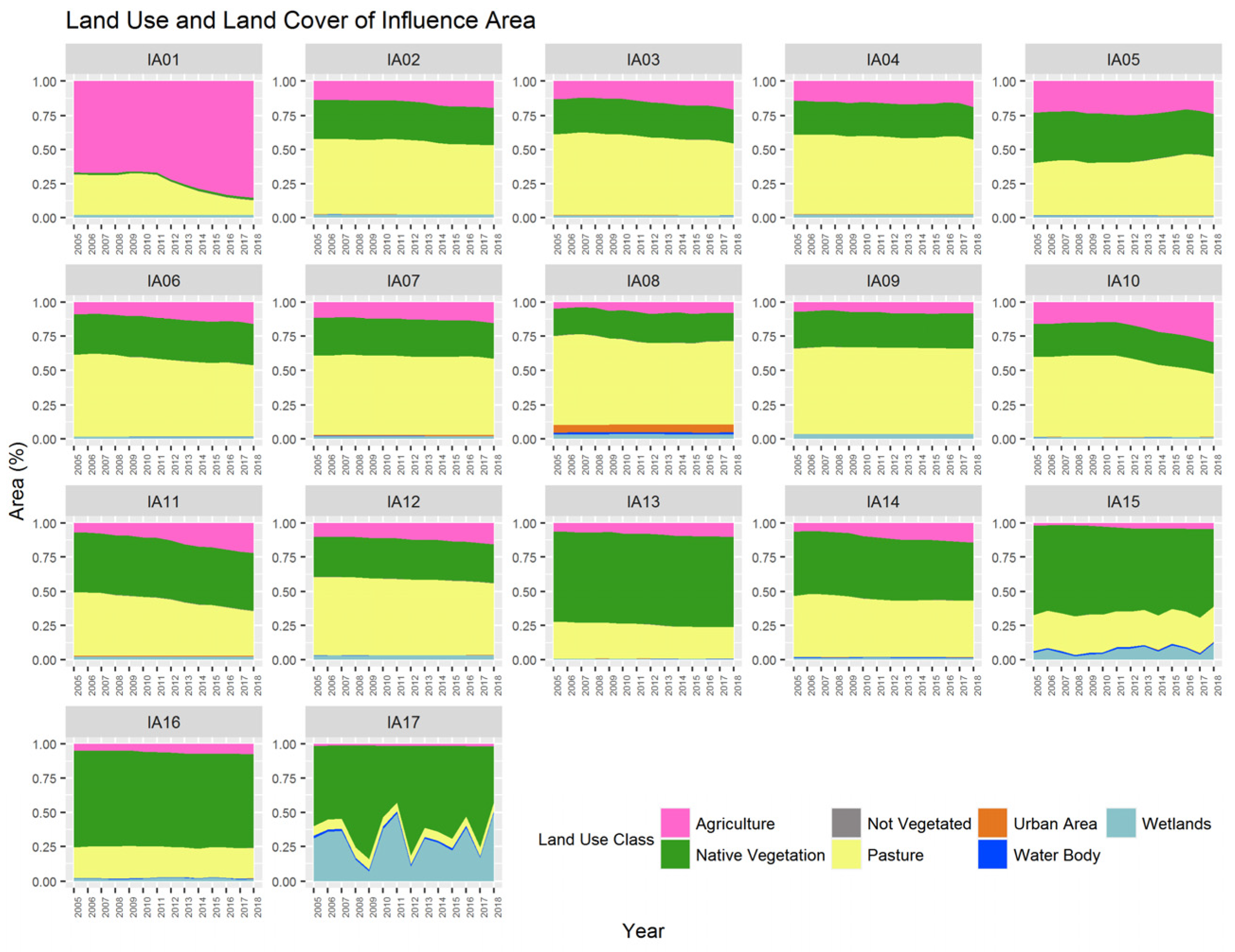

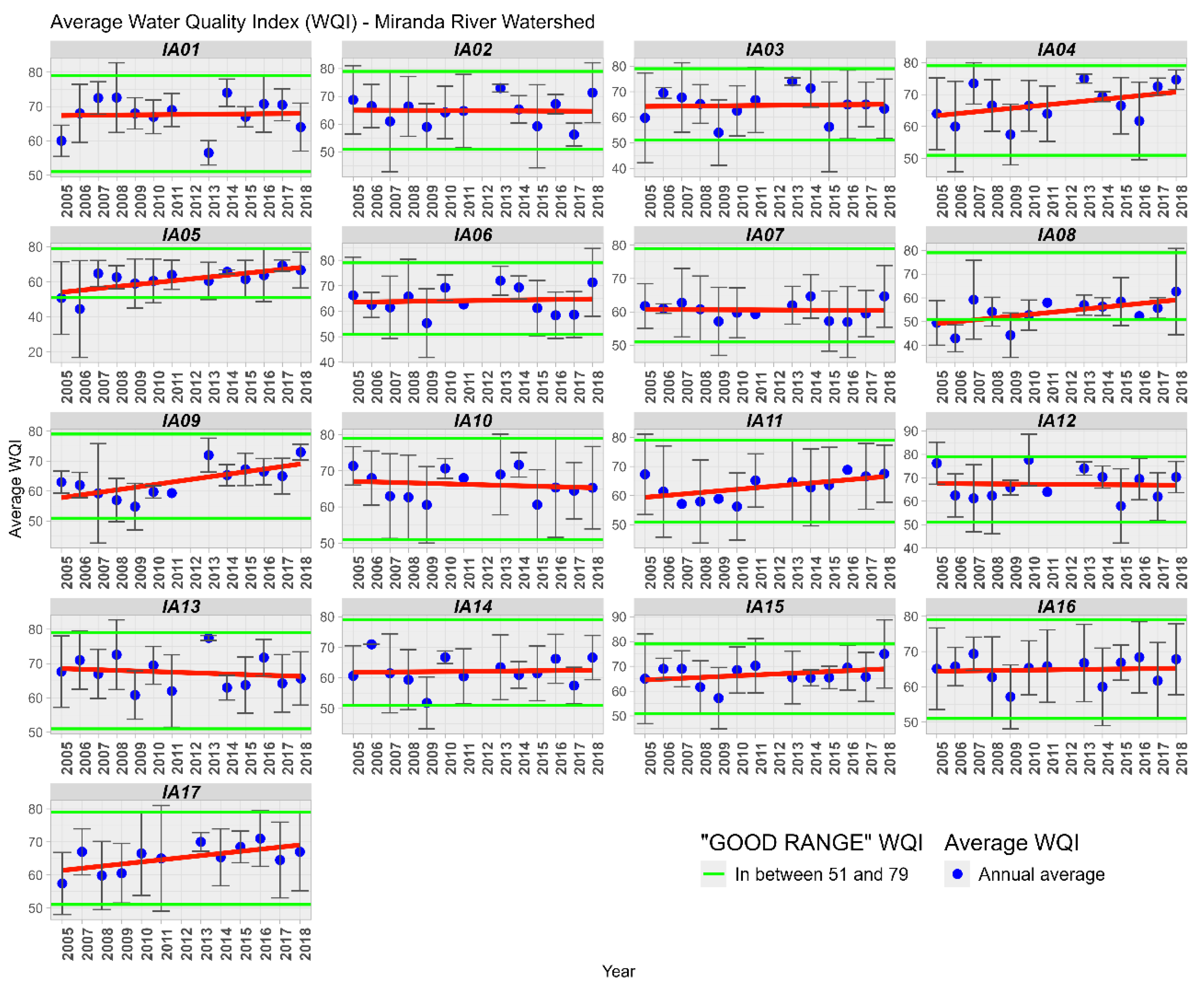
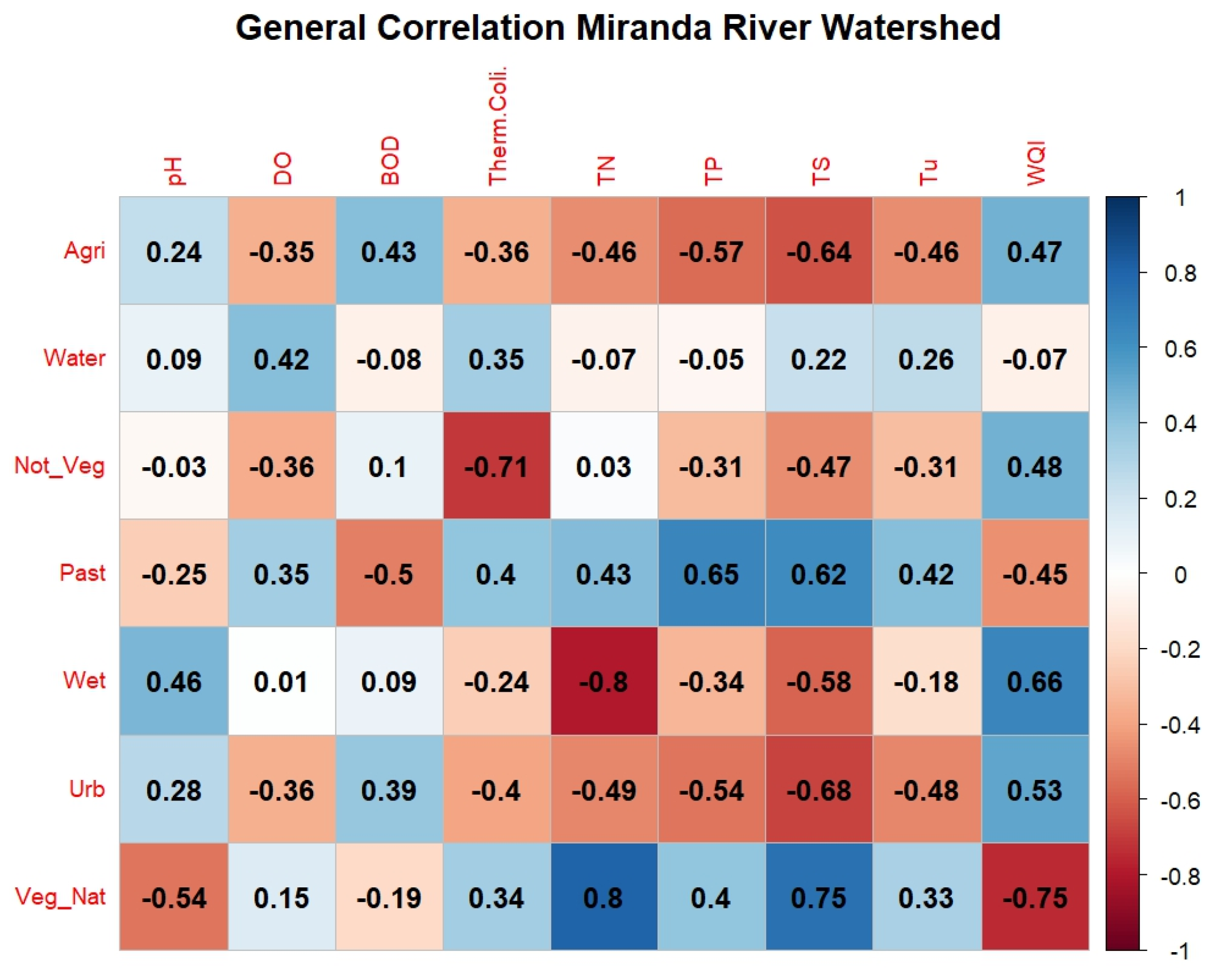
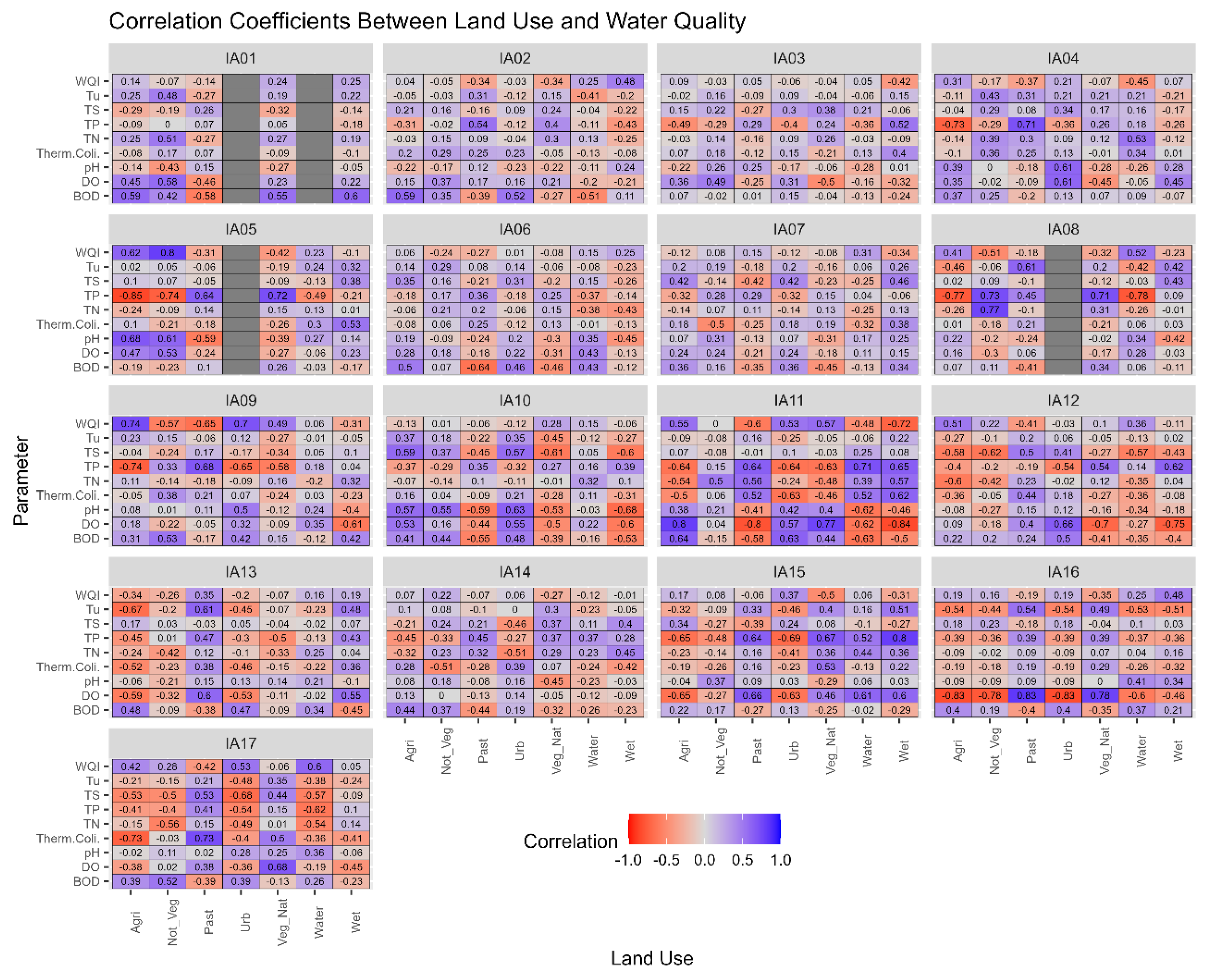



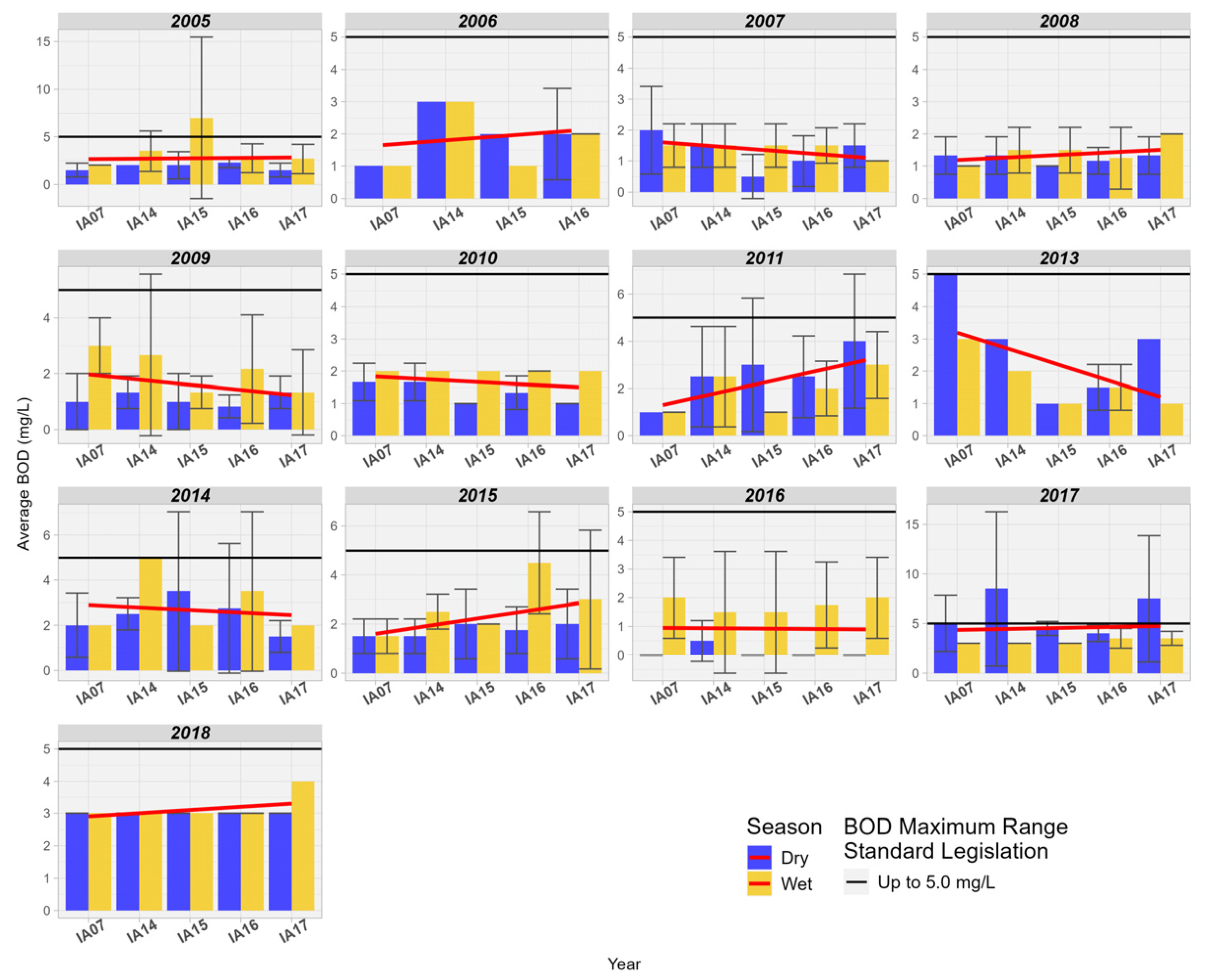
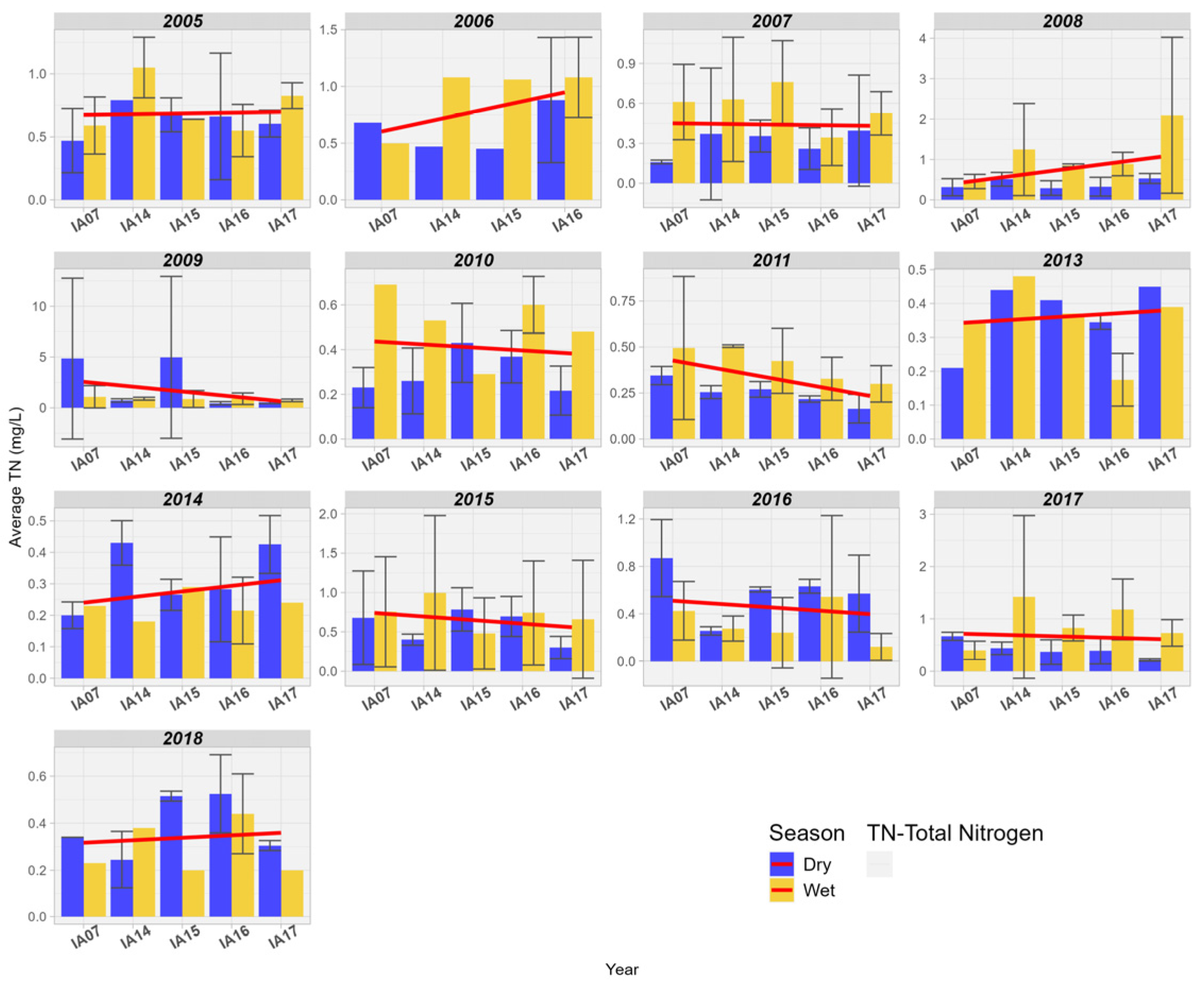
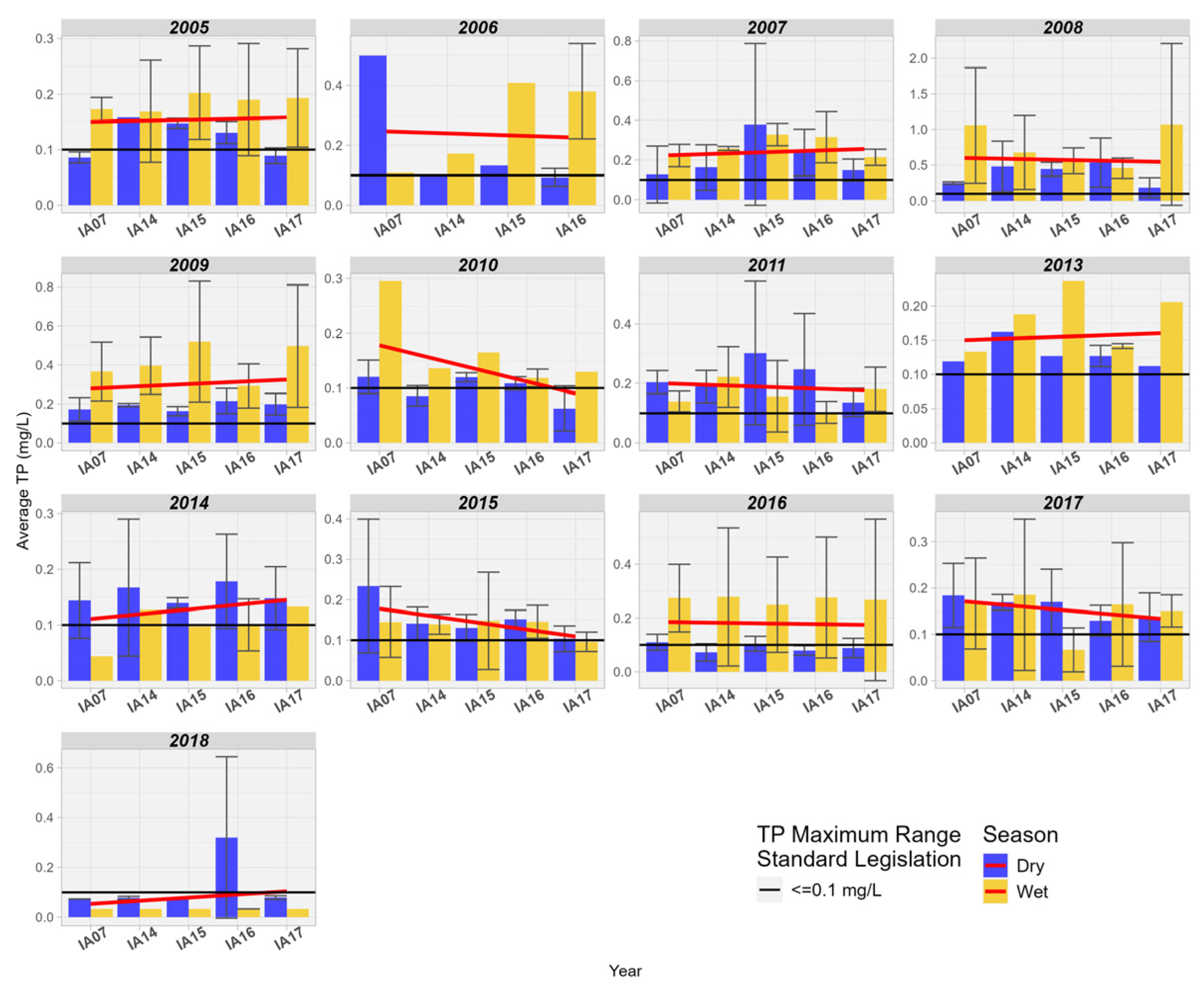
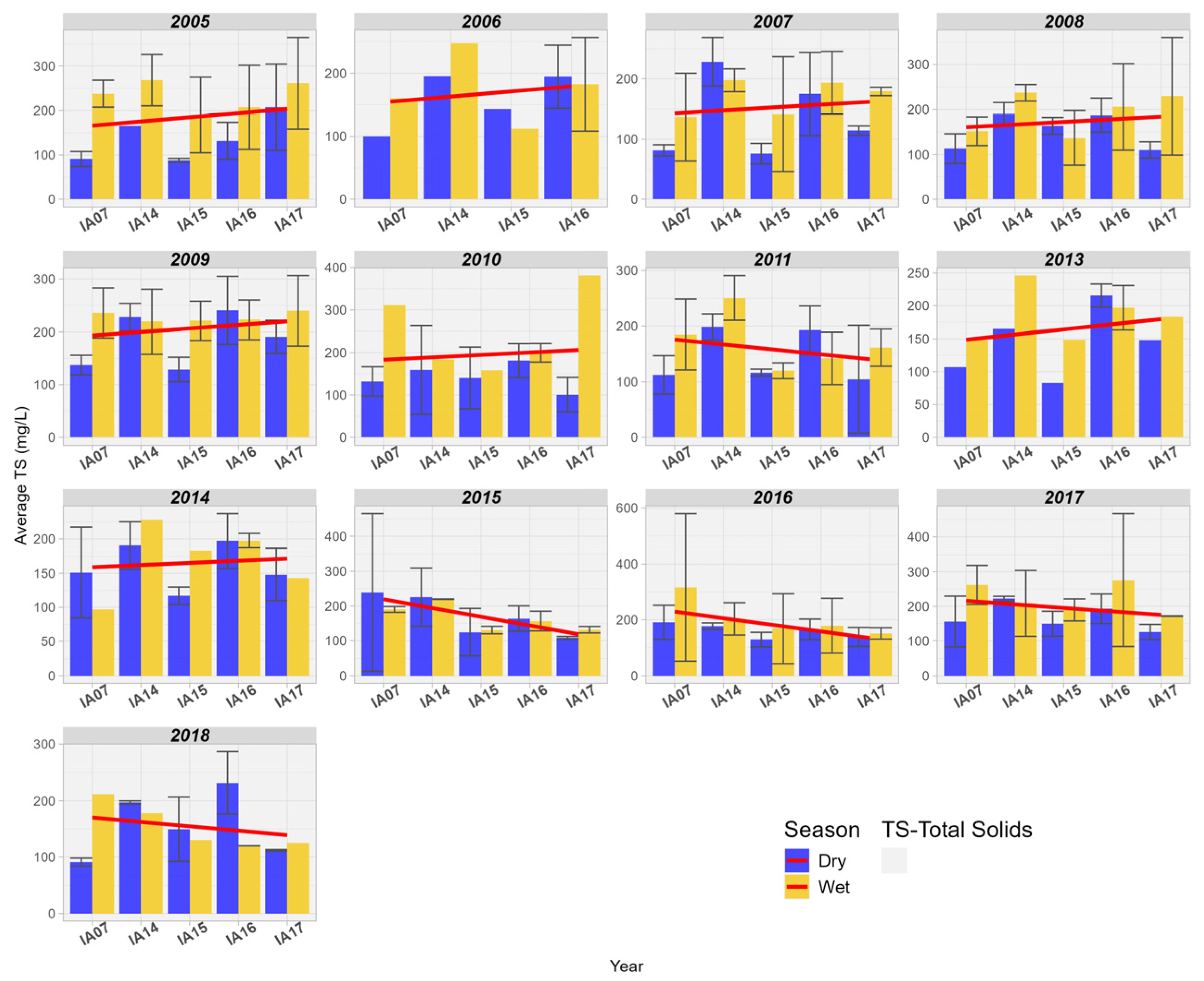


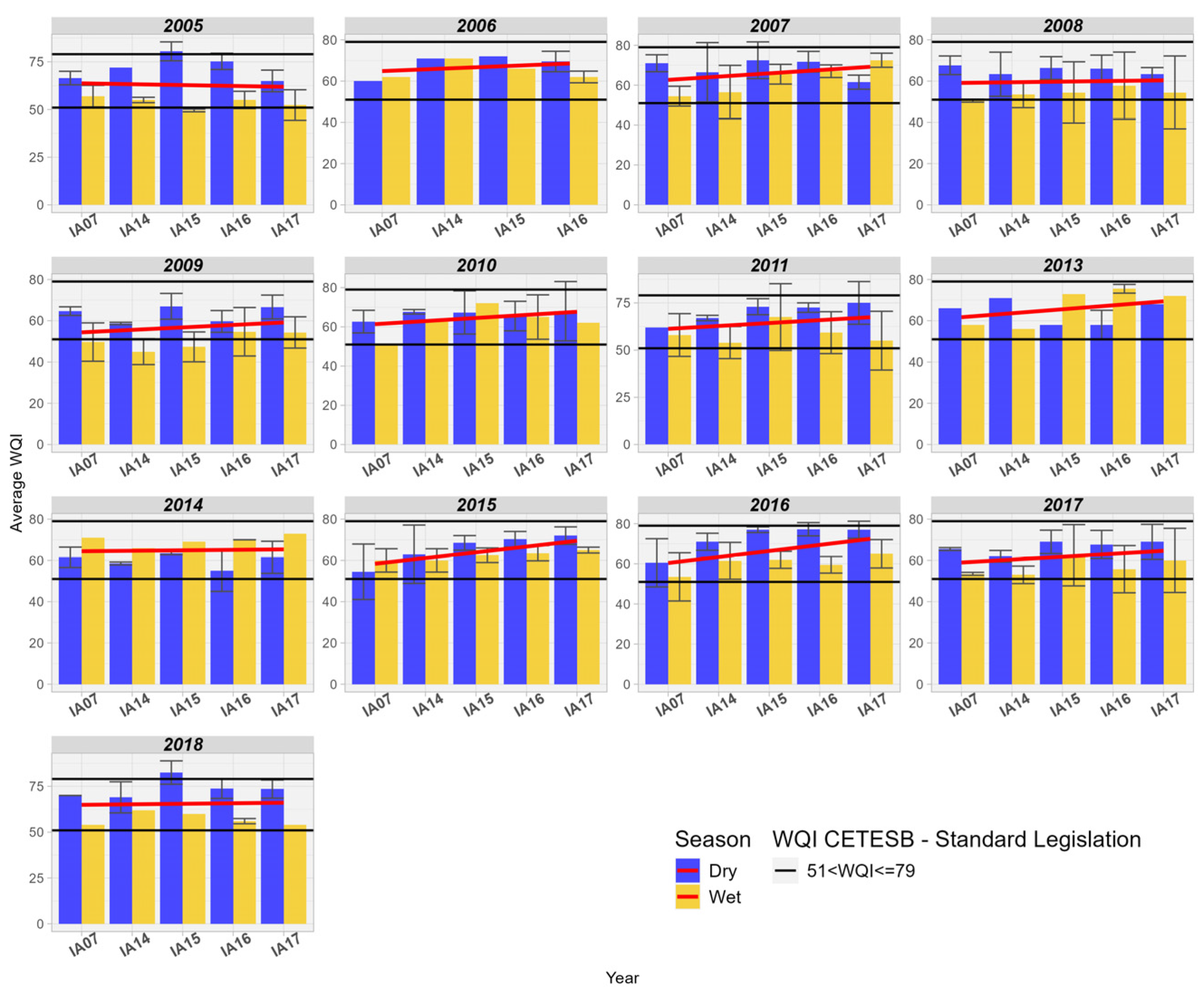
| Name Class MapBiomas | Number Code MapBiomas | Adapted Class |
|---|---|---|
| Forest Formation | 3 | Native Vegetation |
| Savanna Formation | 4 | Native Vegetation |
| Planted Forests | 9 | Agriculture |
| Wetlands | 11 | Wetlands |
| Grassland Formation | 12 | Native Vegetation |
| Pasture | 15 | Pasture |
| Urban Infrastructure | 24 | Urbanized Area |
| Other Non-Vegetated Areas | 25 | Non-Vegetated |
| Rivers and Lakes | 33 | Water Bodies |
| Soybeans | 39 | Agriculture |
| Other Temporary Crops | 41 | Agriculture |
| Parameter | Unit | Analytical Method | Class 2 Limit Value |
|---|---|---|---|
| pH | - | 4500-H [19] | 6–9 |
| Dissolved Oxygen (DO) | mg/L | ASTM D888-12 [20] | >5.0 |
| Biochemical Oxygen Demand (5-day BOD Test) | mg/L | 5210-D [19] | ≤5.0 |
| Fecal coliforms | MPN. 100 m/L | 9221–E [19] | ≤200 |
| Total Nitrogen (TN) | mg/L | NBR 13796 [21] | - |
| Total Phosphorus (TP) | mg/L | 4500 P–B, E [19] | ≤0.1 |
| Total Solids (TS) | mg/L | 2540–C [19] | - |
| Turbidity (Tu) | NTU | 2130-B [19] | ≤100 |
| Water Quality Index (WQI) | - | IMASUL [16] databaseby CETESB [17] equation | - |
| Position | Station Code [19] | Name | River | WGS84 | |
|---|---|---|---|---|---|
| (Influence Areas) | LAT | LONG | |||
| Start | 00MS23AQ2284 | IA07 | Aquidauana | −20.46061619° | −55.83292044° |
| Start | 00MS23MI1292 | IA14 | Miranda | −20.24083000° | −56.39968000° |
| Intermediate | 00MS23AQ2000 | IA15 | Aquidauana | −19.79170028° | −56.80750010° |
| Intermediate | 00MS23MI2147 | IA16 | Miranda | −19.77965000° | −56.81864000° |
| Mouth | 00MS23MI2000 | IA17 | Mouth of Miranda | −19.41998000° | −57.32060000° |
Disclaimer/Publisher’s Note: The statements, opinions and data contained in all publications are solely those of the individual author(s) and contributor(s) and not of MDPI and/or the editor(s). MDPI and/or the editor(s) disclaim responsibility for any injury to people or property resulting from any ideas, methods, instructions or products referred to in the content. |
© 2024 by the authors. Licensee MDPI, Basel, Switzerland. This article is an open access article distributed under the terms and conditions of the Creative Commons Attribution (CC BY) license (https://creativecommons.org/licenses/by/4.0/).
Share and Cite
Carvalho, W.d.S.; Filho, F.J.C.M.; Rodrigues, L.R.; Calheiros, C.S.C. Influence of Land Use and Land Cover on the Quality of Surface Waters and Natural Wetlands in the Miranda River Watershed, Brazilian Pantanal. Appl. Sci. 2024, 14, 5666. https://doi.org/10.3390/app14135666
Carvalho WdS, Filho FJCM, Rodrigues LR, Calheiros CSC. Influence of Land Use and Land Cover on the Quality of Surface Waters and Natural Wetlands in the Miranda River Watershed, Brazilian Pantanal. Applied Sciences. 2024; 14(13):5666. https://doi.org/10.3390/app14135666
Chicago/Turabian StyleCarvalho, Wesley dos Santos, Fernando Jorge Corrêa Magalhães Filho, Lucia Ribeiro Rodrigues, and Cristina Sousa Coutinho Calheiros. 2024. "Influence of Land Use and Land Cover on the Quality of Surface Waters and Natural Wetlands in the Miranda River Watershed, Brazilian Pantanal" Applied Sciences 14, no. 13: 5666. https://doi.org/10.3390/app14135666







